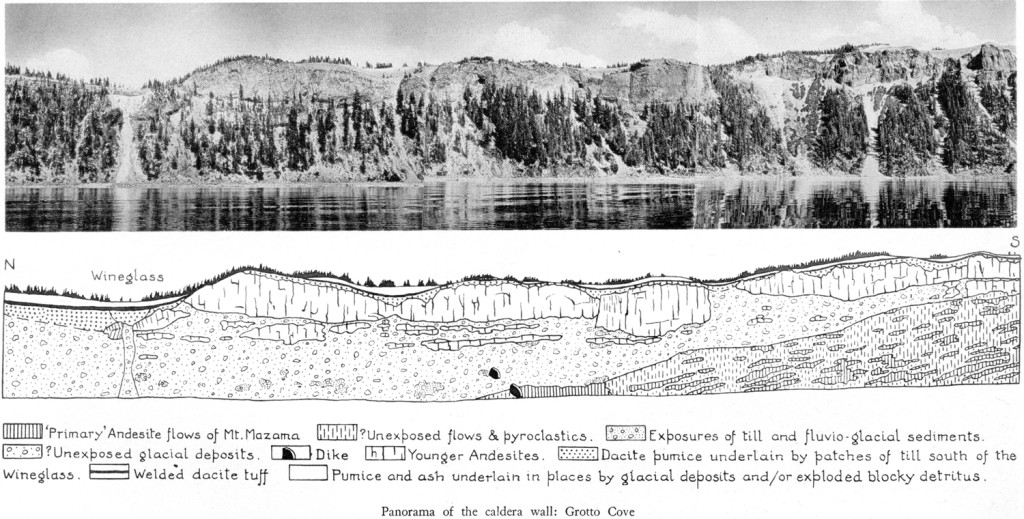The Geology of Crater Lake National Park, Oregon With a reconnaissance of the Cascade Range southward to Mount Shasta by Howell Williams
The Glaciation of Mount Mazama
Evidences of Early Glaciation on the Caldera Walls
The Northeast Wall, from Grotto Cove to Cleetwood Cove
The thin flows which form the “primary slope” of Mount Mazama disappear beneath the water near the Wineglass (plate 24) and reappear near Palisade Point, about 2 miles away. It is precisely in this stretch that the thickest glacial accumulations of any on the caldera walls are to be found.
Plate 24. Panorama of the caldera wall: Grotto Cove
Large glaciers descended the northeast side of Mount Mazama for a long time after the outpouring of the thin flows of andesite. In so doing, they carved a broad and deep valley, and subsequently filled it with morainic mounds and fluvioglacial outwash. Not until several hundreds of feet of such deposits had been laid down did lavas again pour down this side of the volcano.
Owing to slides of pumice and lava from the cliffs above, exposures of glacial material are sporadic and small. Nevertheless, almost the entire wall below the lava cliffs of Grotto Cove, Roundtop, and the Palisades probably consists of glacial debris.
Close to the shore of Grotto Cove, south of the Wineglass, there are many small exposures of bouldery till and finely bedded glacial sands and gravels. Particularly interesting are the rounded glacial boulders embedded in the margins of the dike which traverses the caldera wall in this vicinity. But it is beneath the Roundtop flow that the most spectacular exposures are to be seen. Here, as the photograph, plate 25, shows, the base of the Roundtop flow has the form of a broad W. The explanation is not difficult to find, for wherever the bottom of the lava is exposed it rests on coarse morainic debris. At one place, near the western edge of the flow, the underlying till is exposed to a thickness of 6 feet and many striated boulders are completely embedded in the lava. Both here and in the other smaller exposures beneath the flow, the moraine has been deeply reddened by gas action. Apparently the Roundtop lava flowed down a shallow valley littered with hummocky glacial mounds.
After the flow had solidified, glaciers again advanced down this side of the volcano. The crust of the lava was polished and striated, and patches of bouldery till were left scattered on the surface. Once more the ice retreated. Showers of pumice and then deposits of welded tuff were laid down over the Roundtop flow and the Wineglass. For the last time, the ice readvanced, leaving irregular patches of till on top of the welded tuff. Before the culminating pumice explosions and prior to the formation of the caldera, the ice had once more suffered a retreat, leaving this part of the volcano bare.


